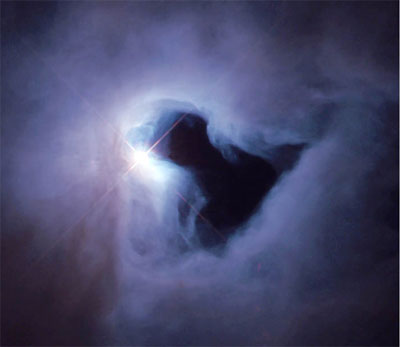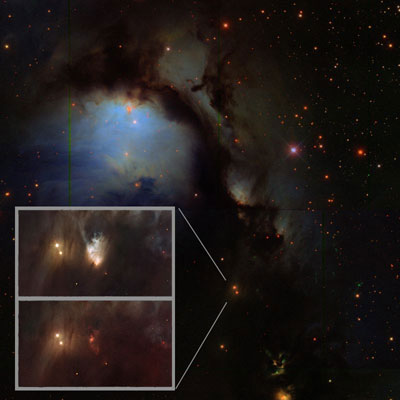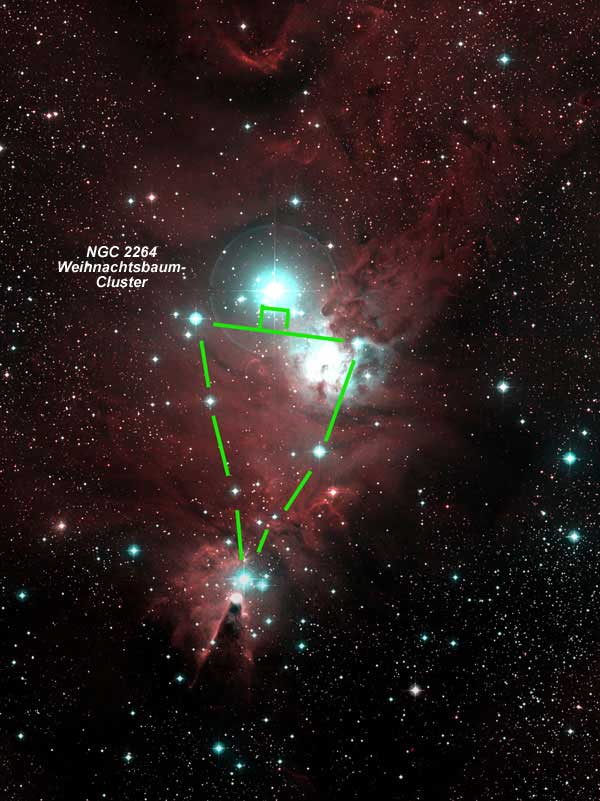exotic
November / December

home Jan/Feb March/April Mai/June July/Aug Sep/Oct Nov/Dec
|
exotic November / December |
 |
RA 04 - 08
Finder charts for all November/December objects as pdf file
Finder charts for ALL exotic objects as pdf file
|
Hind's Variable Nebula NGC 1555 in Taurus Mr T Tauri himself, a prototypical YSO 04 21 57 +19 32 02
Hind's Nebula, NGC 1555, is part of the envelope around the young star T Tauri, prototype of the T Tauri class of young stellar objects (YSOs, see here), reflecting a certain phase of high variability during the early development of stars similar to our sun. The variability of T Tauri is the reason for the variability of its surrounding nebula. While it used to be a relatively bright object around 1852, when John Hind discovered it using a 7-inch refractor, it was all but invisible only 15 years later and was not re-observed until the end of the 19th century. At present, Hind's Variable Nebula is relatively constant at a low level and hence a rather difficult object, that requires aperture and good conditions. If you know what to look for, you're already halfway there. The nebula appears as a very faint and unexpectedly large crescent bending around one side of T Tauri. Under excellent conditions, a splitting of its southern end could be observed and later verified on photographs. The neighboring "double star" may help a lot to get an idea about size of the faint crescent and its distance to T Tauri. In the same direction from T Tauri, but somewhat more distant, Otto Wilhelm Struve described in 1886 another nebula, NGC 1554, that was confirmed by d'Arrest. Whatever it was, it is no longer visible today even in the deepest photographs and possibly never was ("Struve's Lost Nebula").
|
|
|
|
IC 410 Tadpole globules in Auriga 05 23 08 +33 28 40
Despite being not listed in either the Messier catalog nor the NGC, IC 410 is a very conspicuous and bright emission nebula in Auriga. With UHC or OIII filter, it is distinctly visible from my suburban backyard using my small 4.5" reflector. The Tadpoles in IC 410 are so-called globules, which may be the birthplace of new stars. These globules are eroded by the radiation pressure of the central star cluster. The side of the globule that faces the cluster is excited and is visible as a bright rim.
Despite there are many beautiful
pictures of these tadpoles, as for instance by Richard Crisp
|
 |
The Key Hole Nebula NGC 1999 A reflection nebula with a "hole" in Orion 05 36 25 -06 42 43
|
 mouse-over für Markierung
ESO/T. A. Rector/University of Alaska Anchorage, H. Schweiker/WIYN and NOAO/AURA/NSF and Igor Chekalin |
McNeils Nebula in M78 A variable nebula around a young FU Ori star in Orion 05 46 13 -00 05 33 Towards the end of 2011, the nebula appears to have dimmed again and was not visible anymore (considerably dimmer than the two neighboring stars). McNeil's Nebula is relatively hard locate, despite being so close to well known M78. Due to surrounding dark clouds, the area has hardly any field stars and the few remaining ones are very faint. It always takes me some time to be able to hold the few field stars steadily. Just E of the nebula is a very faint double star, that I could never split visually due to its faintness. This double forms an equilateral triangle with two other stars south and west. During all observations, the nebula appeared fainter than the double star, but could be held during the successful observations steadily with averted vision. On the SDSS III image (upper left) the nebula is not yet visible, while the inset and the lower image shows ESO images taken shortly before and during the first brightening.
|
|
Cederblad 62 A bipolar reflection nebula around a young star in Orion 06 07 50 +18 39 27
Ced 62 or NGC 2163 in Orion is a bipolar reflection nebula (RN) around a young star known as a Herbig Be star (and hence a YSO). This is a similar situation as with Hind's Variable Nebula mentioned above, except that the the central star is more massive. This young star does not yet burn hydrogen yet, but derives its energy from its gravitational contraction on the way from a protostar to a main sequence star. Cederblad 62 is light of the star that is reflected off the embedding molecular cloud. The RN does therefore hardly respond to narrowband filters. But even without filters, it is well visible already with an 8-inch at 200x as a diffuse elongated nebula around the central star. With my 22-inch, the structure gets more clearly resolved and the the nebula appears bipolar with fan-shaped lobes on both sides of the star. The northern component is markedly brighter and larger. Such RN are quite common around young pre-main sequence stars. As these young stellar objects are usually surrounded by an optically thick protoplanetary disk, light of the star can leave the system only in a direction perpendicular to this disk and illuminates the surrounding dust. Depending on viewing geometry, this yields a bipolar appearance. Small scale structural changes around the star may further lead to moving shadows that alter the large scale appearance of the RN on a very small time scale (at least for an astronomical object of this size). A prominent example is Hubble's Variable Nebula (NGC 2261) that shows variations on the time scales of weeks. Others even disappear and re-appear, such as McNeil's Nebula in the vicinity of M78 (see below), that was discovered during its 2004 appearance, disappeared again and become brighter again in 2008, or, as mentioned before, Hind's Variable Nebula, NGC 1555 (see above).
|
|
|
|
Sharpless 257 and Friends Three Snow Balls in Orion 06 07 50 +18 39 27
The Sharpless 154 to Sharpless 158 is an interesting group of emission nebula at he border Orion/Gemini. The individual nebula are near-perfect examples of Strömgren spheres. A Strömgren sphere is a spherical area within a hydrogen cloud that is excited by a central star, while the gas outside the sphere remains neutral. The rim of a Strömgren sphere is hence the widest distance to which the UV radiation of the central star can ionize the hydrogen gas. The brightest parts of this group are Sharpless 255 (= IC 2162) and 257. With the 24mm eyepiece at my 22" Dob and with H beta filter, both are well visible as milky round glows with distinct borders of 3' and 4' diameter. The central stars that are responsible for the ionization are as well easily discernible and are both quite exactly in the middle of the respective spheres. West of these two members is another Strömgren sphere, Sharpless 254. This sphere has the double diameter of the other two and is considerably fainter and more diffuse. It is therefore a bit more difficult to see, but is still quite easy under good conditions. The entire group was baptized to the "Three Snowballs" due to their perfect round shape and their milky white appearance with the filter. It fits even with my 22" Dob in the field of view of the finder eyepiece. In particular the contrast between the more diffuse Sharpless 254 and the more compact Sharpless 255 and 257 is fascinating. The nebula respond best to the H beta filter and somewhat less to the UHC filter. With OIII filter, the contrast is very low due to the only low degree of excitation of the molecular cloud. Sharpless 256 is another component of this group that is next to the 257 sphere at its SW rim. Another component, Sharpless 258, is difficult to discern due to a superimposed group of stars and could not be seen with certainty. I have not observed this group yet with smaller telescopes. There are, however, reliable observing reports with 10" telescopes, showing that this group is well within reach of medium sized telescope, at least with the help of an H beta filter.
|

|
The Cone Nebula A dark wedge south of the Christmas Tree 06 41 13 +09 25 45
Christmas season is close and so it's time for the Christmas Tree Cluster, NGC 2264 in Monoceros. But I don't want to focus on the tree itself and the several superimposed reflection nebula around 15 Mon, but rather on the little Christmas star at the top of the tree. In the non-rotated image to the left, the tree is upside-down, while in the telescope, the tree is upright with the treetop at the top, just as it should be. Only a bit south of this treetop star is another tiny star, that is in a very dusty environment and that forms the top of the Cone Nebula. The Cone Nebula is again a stellar cradle, where young stars are being formed in a large and dusty molecular cloud. Similar dark Pillars of Creation can be observed in the summer pendant, the Star Queen in M16. The famous Hubble image is a real classic, despite of the awkward image format due to the WFPC2 cameras field of view. To say it frankly: The cone is considerably more difficult than suggested by all the beautiful images of it, and it is in particular quite a bit more difficult than for instance the Horse Head. You will need a big telescope, dark skies, an H beta filter, and, last not least, a fair amount of patience. By definition of a dark nebula, the cone itself is not what you see, but its edges, that form a very slight contrast to the surrounding nebulosity. As this nebulosity is of only low excitation and hence emits only in HII, an H beta filter is the filter of choice. My first successful observation of the Cone Nebula was in December 2004 with the 20" Dob of our local club with one of the old Lumicon H beta filters. At that time, I could see the eastern edge of the dark wedge. This side is a bit easier than the western edge, as there are no superimposed stars and its contrast is a bit better. During several later attempts with my 22" Dob, I could see both the western and the eastern edge as well as the faint nebulosity that extends from the eastern edge towards east. Under such dark and transparent skies, the Cone really looks like a dark wedge that protrudes into the HII background.
|
|
Sirius B The closest White Dwarf in the solar neighborhood 06 45 09 -16 42 57
Sirius B is the White Dwarf closest to our sun. At a diameter slightly smaller than that of earth, it has a weight almost that of our sun, while its surface temperature of 25 000 K is about four times that of the sun. Sirius B consists largely of fully ionized carbon and oxygen and is stabilized quantum mechanically by its electron gas and the Pauli principle. Its mean density is more than 2 tons/cm3, while the maximum density at its core exceeds even 30 tons/cm3. Its apparent brightness of mag 8.5 is comfortable, and it is actually its close proximity to its blazing mag -1.4 neighbor Sirius A, which renders observation often difficult. We are in the comfortable situation that its separation to Sirius A is presently approaching its maximum value of 11.9" on its highly elliptical apparent orbit (see chart to the left), while it was only a mere 3" in the beginning 90es. Nevertheless, at my latitude of 48°N, I need a stable atmosphere to discern the faint companion. Good seeing conditions granted, Sirius B can be quite easily observed as a tiny starlet almost precisely east of the A component. Under poor conditions, however, Sirius B is completely lost in the speckles of the blazing main component. Unfavorably positioned spikes of Newtonian telescopes may further hamper successful observation oft the White Dwarf. If you are unsure about at which distance to expect between A and B, take a short look at the much easier Rigel system in Orion. Rigel's B/C components appear at a separation of 9.5" to the main component Rigel A (although the difference in apparent brightness is much less challenging as compared with Sirius).
|
|
|
Jones-Emberson 1 A large PN in Lynx 07 57 52 +53 25 17
JoEr-1 (PK164+31.1) is one of the brightest of the large PN. It was discovered in 1939 by Rebecca Jones and Richard Maury Emberson. At the eyepiece, the PN appears annular with a darker center. The ring has two thicker and brighter sections that are situated symmetrically at the NW and SE side. This appearance lend him the nickname Headphone Nebula. The PN responds very well to both OIII and UHC filters, even though not as pronounced as Jones 1 in Pegasus, another PN discovery by Rebecca Jones.
|
|
|
PuWe 1 ... and an even bigger PN in Lynx 06 19 34 +55 36 43
PuWe 1 (discovered in 1980 by Purgathofer and Weinberger on the POSS plates) is one huge PN! Its size and its faintness render him a very difficult object that requires perfect skies. There is only a hint of it on the DSS, as evident from the heavily stretched image to the left. Nevertheless, it is an emission line object and, with filter, within reach for visual observation. The first observation was, to my knowledge, by Frank Richardsen with his 20" Dob. Under less than optimal conditions, I only suspected vaguely some nebulosity in the central part around four little stars that resemble epsilon Lyrae. Later, under excellent conditions in the southern Black Forest with perfect transparency, it was a totally different picture: Together with Matthias Kronberger, I saw the PN as an extremely faint disk with a well defined edge from SE to W. The PN did not appear crescent- or ring-shaped, but was filled. Towards NE, the PN faded away. This observation was with 7mm exit pupil and the Lumicon OIII.
More about the really large PNe is here. |
|
|
mouse over for designations |
IC2169 and Friends A round of reflection nebula right of the Christmas Tree 06 31 00 +10 05 00
The area around IC 2169, about 2 degrees west of the Christmas Tree Cluster NGC 2264 and the Cone Nebula is littered with small reflection nebula. NGC 2247 and IC 446 are small reflection nebula that are concentrated mainly around their illuminating stars. NGC 2245 is a small but very bright RN that has a peculiar shape. It is not symmetric around its star, but has a cometary shape. IC 2169 is the largest of the four RNe and is, compared to the other, much more diffuse and fainter.
About one and a half degrees NNE of this group is Simeis 159, which is a relatively unknown but, still quite bright emission nebula. It consists of two parts that are mainly OIII objects.
|
|
Marco Lorenzi , www.glitteringlights.com |
Sharpless 308 A giant Wolf-Rayet shell in Canis Major 06 54 00 -23 55 00
Starting point for the star hop to Sharpless 308 is o1 CMa. This star is embedded in the open cluster Collinder 121, which is unspectacular even in binoculars and does not really stand out as a cluster. Shifting o1 CMa into the middle of the field of view of the finder eyepiece, you will be surprised by the view when you switch to OIII filtering (most spectacular, of course, with a filter slide or wheel). The OIII filter shows you a ghostly crescent of glowing gas, that extends from o1 CMa first towards NW and then towards N as part of a huge bubble of 40' diameter. This bubble is not related to o1 CMa itself, but is the blown of outer shell of EZ CMA, a Wolf Rayet (WR) star, about 20' N of o1 CMa, in the middle of the bubble. WR stars are supermassive stars with considerable mass loss due to strong stellar winds. The outcome of this process is a shell of gas, that is highly excited by interaction with interstellar medium and which reacts therefore very well to the OIII filter. WR shells are rare, but they are almost always spectacular. The brightest WR shells visible from our northern latitudes are the Crescent Nebula and the shell around WR 134 in Cygnus, Thor's Helmet (NGC 2359) in Monoceros, and Sharpless 308. Fainter WR shells that are still within reach for visual observations are Sh2-80 around WR 124 and parts of the shell around WR 128, both in Cygnus.
With my 14" Dob, the western crescent is the brightest part and can be easily followed with OIII filter. Towards NW, the crescent becomes fainter. on the image to the left and other deep narrowband images one can see a "rupture" of the bubble and a decrease of the surface brightness. With my 22" Dob, I can follow the shell well beyond this area. At around 11 o'clock, there is another condensation where the shell becomes brighter before it slowly fades out in the eastern part. Under excellent conditions with perfect transparency down to the horizon, I could see the entire shell, including the eastern part, that closes the circle towards o1 CMa. With 7mm exit pupil, the shell appeared filled with an extremely faint OIII glow, which disappeared at smaller exit pupils.
|
|
Gum 1 An emission/reflection nebula in the Seagull complex in the Unicorn 07 04 25 -10 27 16
Gum 1 is part of the Seagull Nebula (IC 2177) and is situated at its northwestern edge, forming its head. Alternative designations for Gum 1 are Sharpless 292 or vdB 93. Gum 1 comprises both reflection and HII emission. It can be observed, therefore, both without filter or with an H beta or UHC filter. As compared with the actual Seagull Nebula, Gum 1 is much brighter and very structured. The most prominent structural detail is a pronounced dark notch that protrudes into the nebula from its NE edge. There are many more Sharpless and van den Bergh objects in the vicinity of the Seagull Nebula of which the most conspicuous ones are vdB 95 (at its eastern edge), vdB 94 = Sh 297 = Ced 90 (at its southern end), NGC 2327 (at the middle of the western edge) and Z CMa, a YSO (at the western edge).
|
|
|
Dean Salman , www.sharplesscatalog.com |
Sharpless 311 A bright extended star forming region deep south in Puppis 07 52 19 -26 26 30
NGC 2467 or Sh2-311 in Puppis is an HII region with a small embedded open cluster. The nebula itself is small, but relatively bright. With my 22" Dob, I could discern two darker areas that protrude from the east into the center of the nebula around the little cluster Haffner 18, as well as another distinct dark band that separates the northern part of the nebula. Due to these dark areas and the embedded stars, this object resembles a bit the Lagoon Nebula. Further to the north are a round Strömgren sphere and the small cluster Haffner 19. The nebula is visible easily without filtering, even with 8" aperture, and it reacts well to both UHC and OIII filter. I found it most esthetically pleasing with the UHC filter as the stars were not as suppressed as with OIII filter. With OIII filter, another extension of the nebula becomes visible towards NW of the main mass. This part is 20' to 30' long and forms a crescent that is oriented away from the main nebula and trails in SE-NW direction along a chain of stars. This part of the nebula emits almost exclusively in OIII and is visible in the OIII image to the lower left in its left half.
|
image credit: DSS
![]()
home Jan/Feb March/April Mai/June July/Aug Sep/Oct Nov/Dec